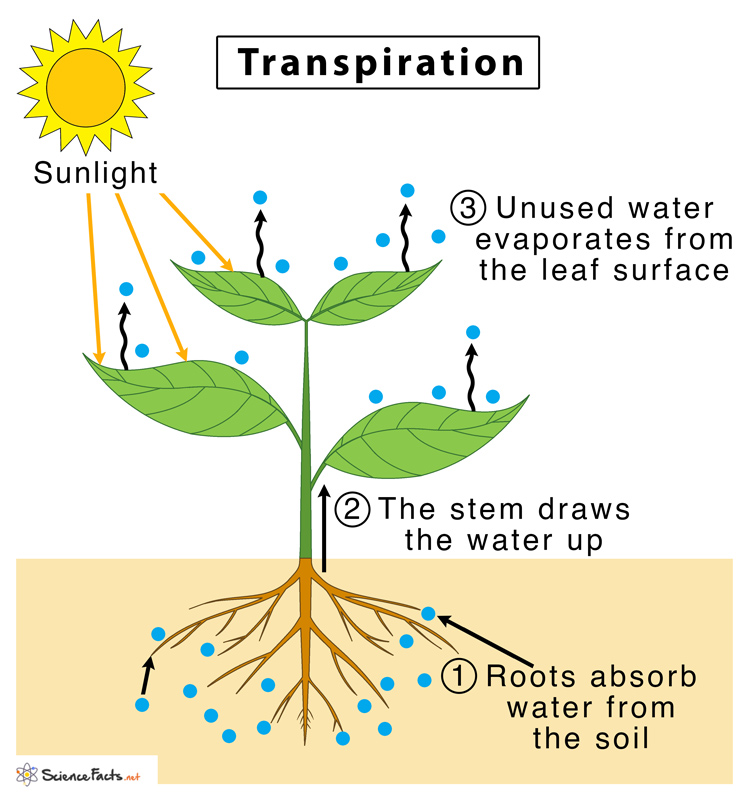Transpiration
What is Transpiration
Transpiration is the biological process by which water is released in the air as water vapor through minute pores called stomata. It occurs through the aerial parts of the plant, such as leaves, stems, and flowers.
How does Transpiration Work in Plants
It happens during daytime when leaves absorb sunlight and get heated up causing water to evaporate from its surface. In order to make up for the lost water, plants absorb water through the roots which get distributed to all its aerial parts causing transpiration to continue.
Factors Affecting the Rate of Transpiration in Plants
Internal Factors
- Structure of leaf: Compact arrangement of leaf cells, presence of hairs, cuticle, and hydrophilic substances such as gums and mucilage reduce the rate of transpiration
- Orientation of leaf: Leaves arranged transversely on the shoot have higher rates of transpiration compared to those arranged perpendicularly
- Number of leaves: More the number of leaves in a plant, higher the rate of transpiration
- Number of stomata: Leaves with more stomata have a higher rate of transpiration
- Surface area of the leaf: Wider the leaf surface, higher the rate of transpiration
External or Environmental Factors
- Temperature: Increase in atmospheric temperature increases the rate of transpiration
- Pressure: Decrease in atmospheric pressure enhances evaporation and thus increases the rate of transpiration
- Light: Increase in light intensity raises the temperature of leaf cells and thus increases the rate of transpiration
- Relative humidity: Increase in atmospheric humidity decrease the rate of transpiration
- Wind: More the wind velocity in the atmosphere more is the rate of transpiration
- Water Content of the soil: Sufficient availability of water in the soil allows stomata to remain open and thus helps transpiration to continue at a faster rate
- Concentration of carbon dioxide: Decrease in the amount of carbon dioxide in the atmosphere favors the opening of stomata and thus increases the rate of transpiration
Types and Examples of Transpiration
- Stomatal transpiration (through leaves) – Loss of water through specialized pores present in the lower surface of leaves called stomata. It accounts for around 80 to 90% of the total water loss from plants.
- Cuticular transpiration (through leaves and stem) – The water lost through the impermeable covering present on the leaves and stem of the plant called the cuticle. It accounts for around 20% of the total transpiration in plants.
- Lenticular transpiration (through bark) – The loss of water through the tiny openings present on the woody bark of the plant called lenticels. It accounts for around 0.1% of the total transpiration in plants.
Why is Transpiration Important in Plants
- Helping in the conduction of water and minerals to different parts of the plants
- Concentrating the absorbed sap in the plant cell that helps in osmosis
- Maintaining the turgidity of the cell and thus in performing cell division
- Helping in the growth of the plant
- Keeping the plant cool and moist during summer
FAQs
Ans. Curtis in 1926 said transpiration a necessary evil because although it is beneficial to plants for its survival and metabolism, an excessive loss of water may sometimes result in wilting, desiccation, loss of energy, and even sometimes death of the plant. Excessive transpiration is also found to adversely affect the photosynthetic activity of the plant.
Ans. Transpiration occurs only in vascular plants, those having water-conducting tissues – xylem and phloem. Xylem helps in the transport of water and minerals from the soil to all parts of the plant and phloem distributes sugar and other organic nutrients made by the plant from the leaves to all its parts.
Ans. Plants loose gallons of water every day through the process of transpiration. About 99% of the water absorbed by roots is lost by transpiration.
Ans. The rate of transpiration is measured with the help of an instrument called potometer.
Ans. Plants reduce transpiration through a number of adaptations and modifications such as reducing the surface area of the leaf, presence of leaf hairs, and performing photosynthesis during the night.
Ans. Transpiration pull is the result of water loss through evaporation from the aerial parts of the plant, such as the leaf, stems, and flowers. In order to make up for the water loss, the plant absorbs more water from the soil using the process called transpiration pull.
Ans.No, not all plants perform transpiration at the same rate as there is a specific relationship between transpiration and habitat of a plant. For example, succulent plant such as cactus and thorns living in a dry environment needs to conserve water and thus have a reduced leaf surface, which has a lesser number of stomata than a plant living in a tropical environment.
Ans. Transpiration helps to absorb water from the soil that is used in photosynthesis to produce food for plants.
Ans. The basic difference between evaporation and transpiration is that evaporation is a physical process involving the loss of water from any exposed surface of liquid while transpiration is the biological process of losing water from the aerial parts of the plant.
-
References
Article was last reviewed on Friday, February 17, 2023




